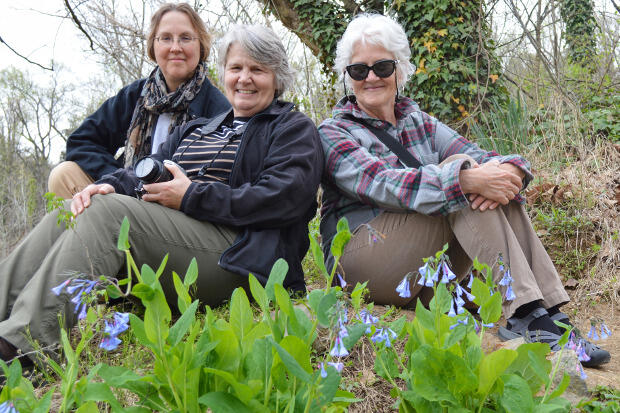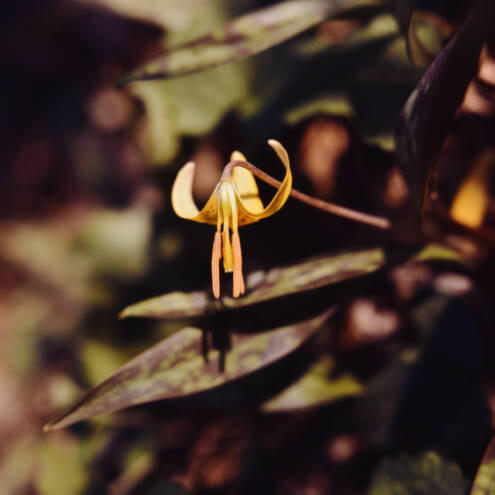
<br>Photo by Leah Small, University Public Affairs
April 11, 2017
As invasive plant species overwhelm the James River Park System, VCU plant life advocates fight to protect native wildflowers
Share this story
The efforts of Newton Ancarrow, one of the first environmentalists to fight for protection of the James River and its natural areas, lives on through the work of VCU and community environmental advocates.
Ancarrow was known for photographing and documenting more than 400 species of wildflowers from 1968 to 1971. He discovered the flowers as he searched for raw sewage outlets in what is now the James River Park System. Ancarrow used his wildflower pictures in a slideshow presentation he gave to Richmond garden clubs, women’s groups and civic organizations to garner support for a healthier river. Last year, wildflower photographs in his “Flower Show No. 2” presentation were digitized by VCU Libraries and shared online in the Ancarrow Wildflower Digital Archive. The original slides are housed in the library of Lewis Ginter Botanical Garden.

Ancarrow Wildflower Digital Archive
Now, a partnership between VCU faculty, a group of botanical illustrators and the Ginter library is using the archive to educate the public about the existence of these flowers, and to protect their habitat from invasive plant species. These invasive species are non-native flora that rapidly reproduce and overtake the habitats of native plants. As a result, pollinators and animals that depend on native plants as a nutritional source are disadvantaged and biodiversity can decrease.
“The park has been invaded by invasive species and they are pervasive throughout,” said Anne Wright, an assistant professor in the Department of Biology and member of the park’s Invasive Plant Task Force. “We want to know if this has had a big impact on Ancarrow’s species list.”
Wright is working with Judy Thomas, Ph.D., an assistant professor in the School of Social Work and botanical art instructor at Lewis Ginter Botanical Garden; and Janet Woody, librarian at Lewis Ginter, to attract park visitors who will identify the flowers species found by Ancarrow. The goal is to evaluate whether the plants are greater or less in number due to invasive plants.
“We want to revisit the areas where he originally walked and photographed these flowers to see if they are still there,” Wright said. “Maybe we will match everything on his list and see more than he saw. Maybe we will see less.”
The three partners will also call on botanical artists and illustrators to create the “Plants of the James River” project. Artists and illustrators will create activities and exhibits to aid the public in differentiating between invasive and native plant species. In botanical illustration, plant life is portrayed with the highest degree of scientific accuracy possible. Botanical artists still strive for accuracy but focus closely on aesthetics and composition.
On the path of Ancarrow

Botanical enthusiasts who would like to document the wildflower species identified by Ancarrow may refer to the Ancarrow archive and log their findings at the James River Park System’s iNaturalist.org page, part of Wright’s Science in the Park website. The page allows both amateur and avid naturalists to log pictures and observations of flora and fauna observed in the park. Organizers ask participants to click the “obscure” option when identifying the location of wildflower sightings to ensure the protection of plant life.
Woody hopes to draw from the high number of people who use the James River Park System for recreation.
“The James River Park System is so heavily used, so people are here. We just want them to start looking down at the ground to see what they can before they ride their bikes through,” Woody said.
Throughout April and May, visitors can see small and pink spring beauty blossoming low to the ground, Virginia blue bells, bright trout lilies and more.
The “Plants of the James River” project

The group also wants park visitors to be able to identify the invasive plant species that threaten to overcrowd native flora. Park visitors will use botanical illustration and art as learning tools.
Thomas, an accomplished botanical artist, will team with three other artists — Paula Blair, Cheryl Exley and Susan Estes — to create educational activities and exhibits. The group will invite regional botanical artists to participate in sketching sessions to produce original portrayals of invasive and native plant species.
Thomas said botanical illustration and art are perfect mediums to engage and educate park visitors because they balance science with art.
“Botanical artists and illustrators work to show the plant in all its glory, share the details of the plant so it can be correctly identified and help the viewer understand the unique characteristics of the plant — both good and problematic — in an artistic way,” Thomas said. “Botanical artists work to share the beauty and fascination of plants, especially when they are in the ecological niches in which they evolved.”
The Invasive Plant Task Force
In an effort to control the spread of invasive species, park volunteers and environmental activists formed the Invasive Plant Task Force in 2015 to curb the spread of these flora species and restore damaged habitats.
|
Four things anyone can do to stop the spread of invasive species 1. Don’t plant flora included in the Virginia Department of Conservation Resources’ Invasive Plant Species List. Gardeners should also remove any invasive plants from their property. |
At the same time, the private consulting firm Vanasse Hangen Brustlin proposed the development of a management and restoration plan and baseline study on invasive plant levels in the park. VHB trained task force members in the systematic identification and quantification of invasive species. The task force also works to educate the public about what can be done at home to prevent the spread of invasive plants.
Controlling the spread of invasives is important for maintaining biodiversity and the health of fauna dependent on native plants, biologists have said. The weight of non-native vine species such as English ivy often weakens and topples the park’s native trees. If trees are too overwhelmed by vines, they may not be exposed to enough sunlight to effectively photosynthesize, said Laura Greenleaf, a founding member of the task force.
The majority of the park is within a 50 to 75 percent invasive species cover class, according to the VHB baseline study. Plant cover classes measure the percentage of ground level surfaces covered by vegetation.
“Any member of the Invasive Species Task Force will tell you that invasive plant species are the single greatest ecological threat to the parks system,” Greenleaf said. “It’s extraordinarily severe.”
Subscribe for free to the VCU News email newsletter at http://newsletter.news.vcu.edu/ and receive a selection of stories, videos, photos, news clips and event listings in your inbox every Monday and Thursday.
Subscribe to VCU News
Subscribe to VCU News at newsletter.vcu.edu and receive a selection of stories, videos, photos, news clips and event listings in your inbox.






